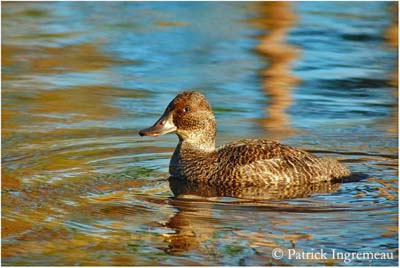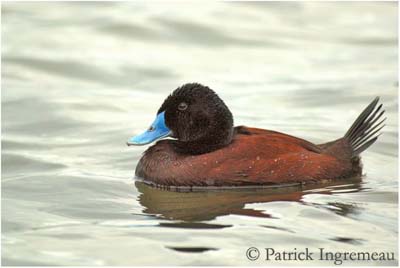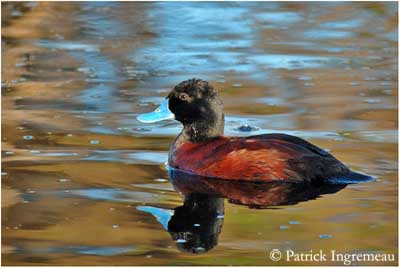
Blue-billed Duck
Oxyura australis
Anseriforme Order – Anatidae Family
BIOMETRICS:
Length: 35-44 cm
Wingspan: 60 cm
Weight: M: 850 g; F : 810 g
LONGEVITY : Up to 16 years
DESCRIPTION:
Blue-billed Duck is endemic to Australia.
Adult male in breeding plumage has rich chestnut back. Wings are dark brown. Upper tail feathers are brown-black, flecked with chestnut.
Underparts are chestnut too. Fore neck, upper breast and flanks are chestnut. Lower breast, belly and vent are paler, flecked with dark brown. Undertail feathers are whitish, speckled with dark brown. Underwings are greyish.
Head and neck are glossy black, sometimes tinged with chestnut in fresh plumage. Bill is bright blue with greyish nail. Eyes are brown. Legs and webbed feet are grey.
Adult male in eclipse resembles female, with head and neck darker, and flanks washed pale brown. Bill is duller and greyer.
PROTECTION / THREATS / STATUS:
Blue-billed Duck is threatened by modification and loss of its habitat. Clearing, draining of wetlands, and burning, are the most important threats for this species.
According to the different locations in Australia, Blue-billed Duck is listed from secure to vulnerable (New South Wales).
It is protected by law in all states, and it is forbidden to shot them.
Fr: Erismature australe
All : Schwarzkinn-Ruderente
Esp : Malvasía Australiana
Ital : Gobbo australiano
Nd : Australische Stekelstaart
Russe : Австралийская Савка
Photographs by Patrick Ingremeau
TAMANDUA
Text by Nicole Bouglouan
Sources:
HANDBOOK OF THE BIRDS OF THE WORLD vol 1 by Josep del Hoyo-Andrew Elliot-Jordi Sargatal - Lynx Edicions - ISBN: 8487334105
GUIDE DES CANARDS, DES OIES ET DES CYGNES – de Steve Madge - Delachaux et Niestlé - ISBN: 2603013769
Birds in backyards (Birds Australia and Australian Museum)
Wikipedia (Wikipedia, The Free Encyclopedia)

Adult female has darker plumage than male. She has dull dark brown plumage, finely barred with yellowish-brown. Chin and throat are brown speckled with black.
Head is dark brown with dusky spots, and duller than male. She has grey-brown bill.
Juvenile is similar to female but paler. It has grey-green bill.
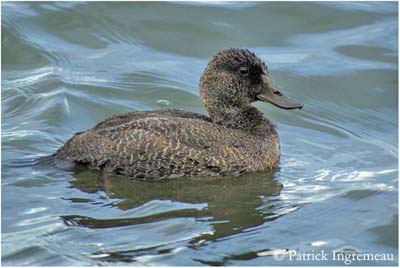
VOICE:
Blue-billed Duck is relatively silent, except during displays. Male utters rapid rattling low-pitched, and female responds with soft, low “quack”.
HABITAT:
Blue-billed Duck form large flocks in winter, on large, open freshwater dams and lakes with deep water. It is also found in large rivers and saline water bodies in non-breeding season.
But this species prefers deep, permanent, freshwater swamps with dense vegetation.
RANGE:
Blue-billed Duck is found in southern Australia, in wetlands of south-east and south-west of the continent, and in Tasmania.
They moult in coastal lakes of Victoria and South Australia.
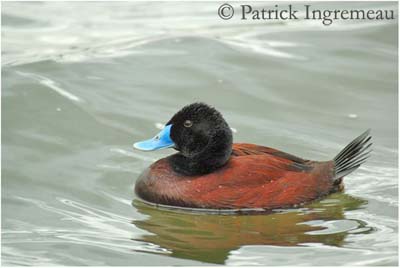
BEHAVIOUR:
Blue-billed Duck can feed by diving or on the surface, in permanent freshwater areas where water is clear and quiet. It feeds mainly in late afternoon and early morning. It feeds far from the shore, often in dense cover in central parts of the wetland.
Blue-billed Duck may be nomadic after breeding season. Young birds migrate to southern areas where they moult. Dominant males don’t migrate.
During courtship displays, male raises its tail which is usually held flat on the water. Male is polygamous, and pair-bonds last only for copulation and laying of the eggs. Male lives in its territory where it attracts female for copulation.
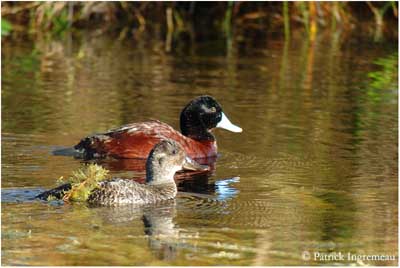
When it is threatened, Blue-billed Duck prefers to dive instead to take-off. It may fly if disturbed but it will dive if approached.
FLIGHT:
Blue-billed Duck flies low to the surface. It needs to run over water before take-off. In flight, it performs very rapid wing beats.
REPRODUCTION:
Breeding season is variable, but usually, Blue-billed Duck breeds from August to November.
It nests in dense vegetation, near the shore, among reeds and usually over water. Bowl-shaped nest is made with dead leaves (Typha). Interior may be slightly lined with down. This species nests solitary.
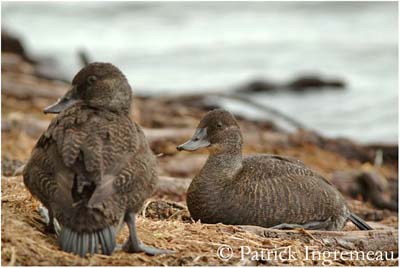
Female lays 5 to 6 eggs. Incubation lasts about 27 days. Young fledge at about 35 days after hatching. Male doesn’t take part in nesting duties.
Young birds disperse in April-May to non breeding areas for moulting.
DIET:
Blue-billed Duck feeds on aquatic insects and larvae. It also consumes seeds, buds, stems, leaves and fruits of several aquatic plants, emergent or submerged. They also feed on aquatic invertebrates such as crustaceans, molluscs, spiders…
